Road Warriors 2019, Part 3: The Top Sports-Production Highlights From Across the Pond
Behind the Scenes at FIA World Ski Championships, French Open, FIFA Women's World Cup, Wimbledon, and The Open Championship
Story Highlights
Following on the heels of a year that saw both the 2018 PyeongChang Olympics Games and the 2018 FIFA World Cup, one might have expected the 2019 sports-production calendar to be a bit quieter. As this year draws to a close, it’s clear that that could not be farther from the truth. While there were plenty of massive stateside productions in 2019 (check out PART 1 and PART 2 of Road Warriors for a look), European production crews were as busy as ever.
Here is a look back at many of the events where SVG Europe were onsite, including FIA Alpine World Ski Championships, French Open, FIFA Women’s World Cup, Wimbledon, and The Open Championship.
FIA Alpine World Ski Championships
Åre Ski Resort, Åre, Sweden
February 5-17
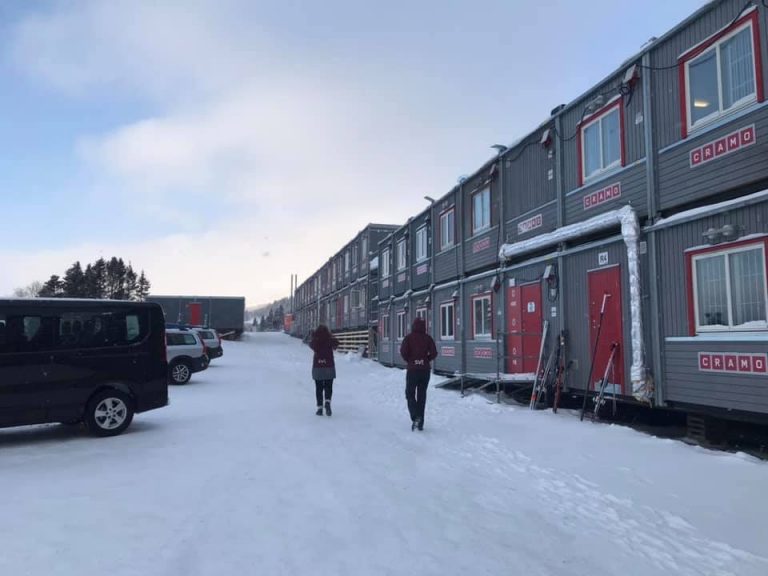 Sweden’s SVT and Infront broke new ground in remote production during its host production coverage of the FIS World Ski Championships when it sent 80 camera signals from the course via two 100 Gbps fiber circuits from Telia to three control rooms in Stockholm.
Sweden’s SVT and Infront broke new ground in remote production during its host production coverage of the FIS World Ski Championships when it sent 80 camera signals from the course via two 100 Gbps fiber circuits from Telia to three control rooms in Stockholm.
Adde Granberg, SVT, director of technology, CTO, said the accomplishment at the World Ski Championships shows how far things have come since 2012 when SVT put remote production to the test for the London Olympics. This event, he said, shows the full potential of remote production.
“It’s not about new technology, it’s about a new way of working,” he explained. “This has nothing to do with IP as the facilities at the course are the same if we were not using IP. Only the transport of signals is over IP.”
About 150 people were at the course, including technicians, the camera people, and the director. The director had access to a control panel to control the Grass Valley vision mixer located in Stockholm where a production team of about 40 created the ultimate coverage.
Grass Valley cameras were the make of choice, serving content to EVS replay operators in Stockholm. FIS handled the creation and management of graphics which were then integrated with the produced feed.
French Open
Stade Roland Garros, Paris, France
May 26 – June 29
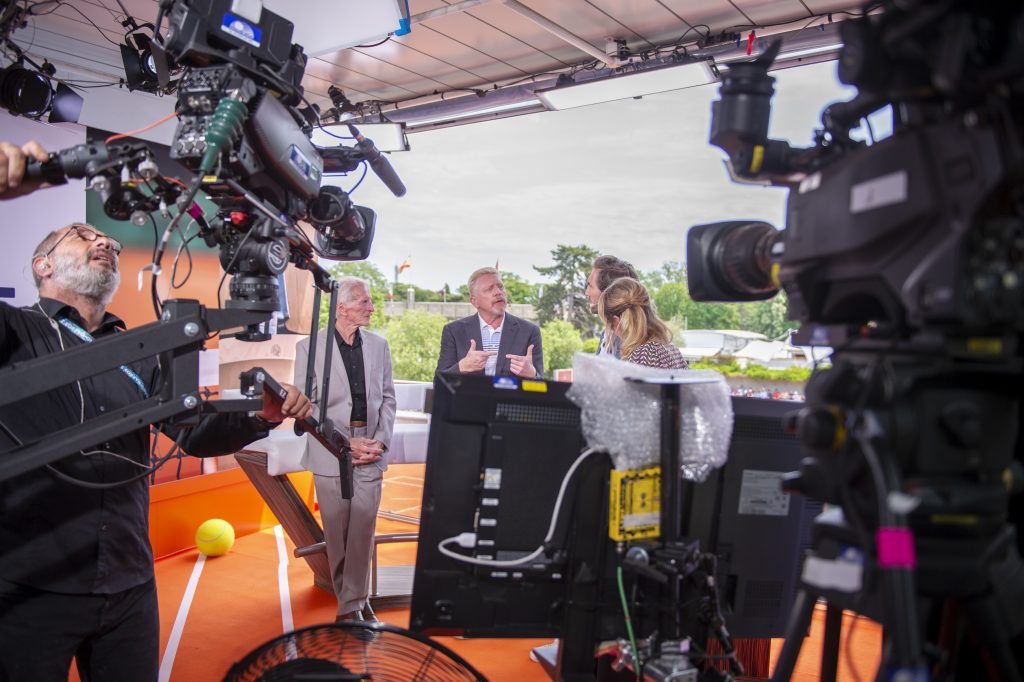 The Roland Garros French Open tournament in Paris offered tennis fans plenty of stellar matchups and Eurosport, with broadcast rights in more than 50 territories, was on hand to make sure that all of them resonated with viewers across Europe.
The Roland Garros French Open tournament in Paris offered tennis fans plenty of stellar matchups and Eurosport, with broadcast rights in more than 50 territories, was on hand to make sure that all of them resonated with viewers across Europe.
This was the 31st consecutive Roland Garros tournament that Eurosport has delivered and there were more than 200 staff onsite producing coverage for 10 localized Eurosport versions distributed across the continent. The channel delivered every minute of more than 600 matches live. Coverage from all 16 courts (as well as all 160 qualifying matches) was produced and available via the Eurosport Player.
With Eurosport’s main production facility located in Paris (and relatively close to Roland Garros, home of the French Open) it was no surprise that the European sports powerhouse looked to leverage its own facilities as much as possible. Last year the broadcaster brought back a finished feed and then integrated it for playout, but this year, all camera signals came back alongside the host feed and were cut from control rooms there.
The team at Roland Garros had 14 unilateral cameras in use to cover activities across the grounds, and onsite, there were teams from Eurosport France, Germany, Norway, Spain, the UK, Russia, and Italy.
Two studios and a control room on site at Roland Garros gave the production teams flexibility so that the different production teams could best meet the needs of viewers back home. The Paris facility had 14 control rooms and a studio, which gave the team a chance to integrate things like virtual and actual reality elements.
FIFA Women’s World Cup
France
June 7 – July 7
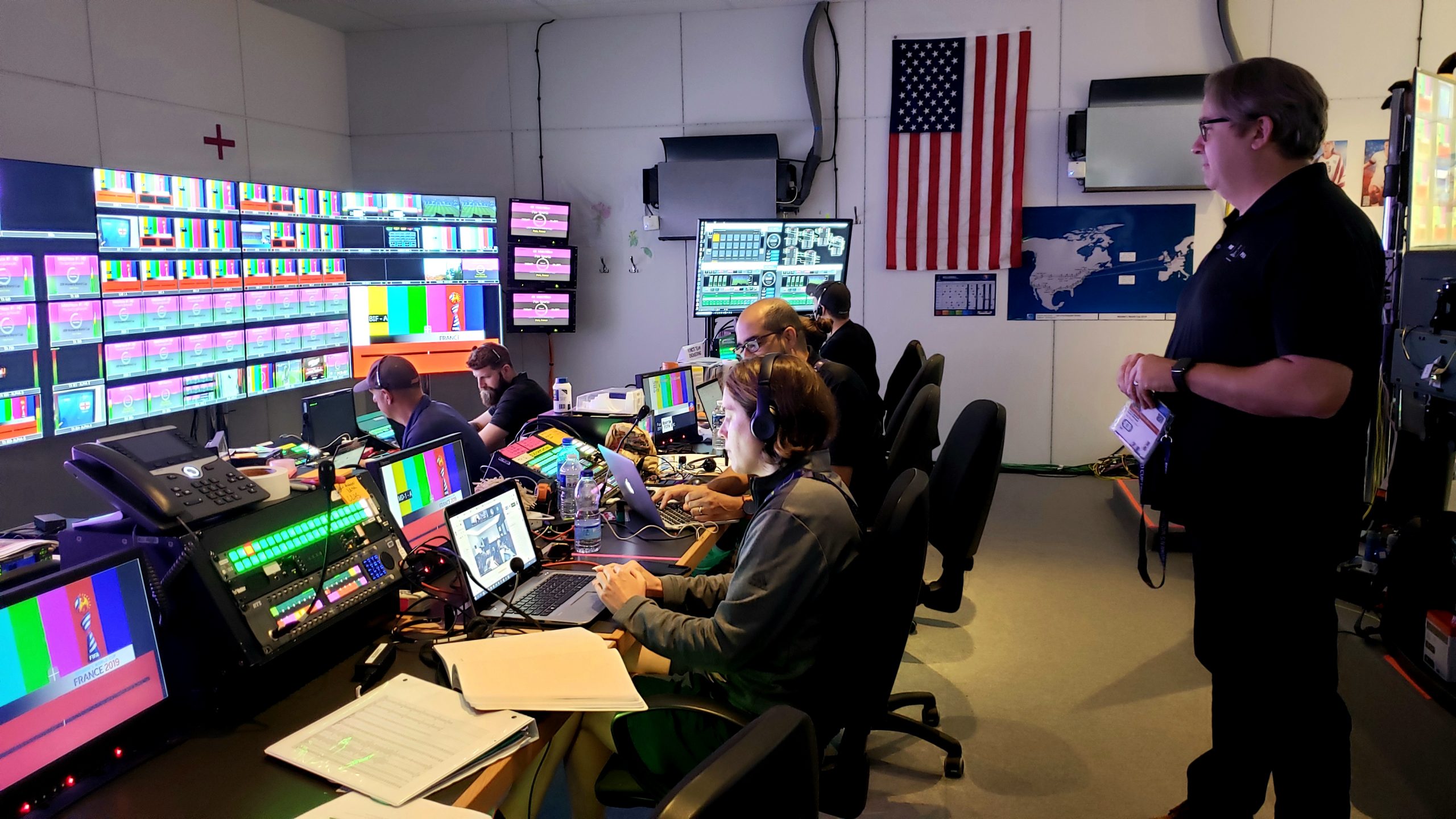 The beginning of the 2019 FIFA Women’s World Cup in Paris marked the end of a long period of planning in which Fox Sports made use of skills the team developed in Canada, home to the previous Women’s World Cup in 2015, and in Russia during the Men’s World Cup last summer.
The beginning of the 2019 FIFA Women’s World Cup in Paris marked the end of a long period of planning in which Fox Sports made use of skills the team developed in Canada, home to the previous Women’s World Cup in 2015, and in Russia during the Men’s World Cup last summer.
One of the first things viewers noticed was the studio-show set, which was located at the Café de l’Homme. Paris has plenty of iconic views, but it is the sight of the Eiffel Tower that resonates with people around the world, and the view from the Café — part of the Musee de l’Homme — did not disappoint.
The studio had 10 cameras, including a 50-ft. SuperTechno50 crane with a Stype kit for augmented-reality graphics that could show sweeping shots of the Palais de Chaillot and the Trocadéro. There was also a beauty camera that used LiveU’s Matrix IP cloud video-management platform to make it available to Fox TV stations that wanted to integrate live shots into their newscasts.
EVS XT-VIA operations, graphics, and playout were done in Los Angeles and the technical director in Paris cut to tape machines located in Los Angeles, not in a B unit. Similarly, the graphics team in Los Angeles controlled three Viz engines in Aurora, and the prompter crew also worked remotely. Bexel helped outfit two trailers located in Fox Sports’ Pico studio lot, and a Century Link trailer helped pull in 120 Gbps of data from Paris.
The Fox facility in Los Angeles also built two rooms for off-tube needs because all audio and video passed through a control room in Los Angeles. The commentary, whether off-tube or onsite, was matched with a UHD feed that ultimately was downconverted to 720p for distribution to viewers.
This was the first time that a Women’s World Cup had a proper building for its International Broadcast Center (in 2015, the IBC was housed in office trailers). Although Fox has a relatively small footprint of only 300 sq. meters, it packed a lot of technical punch. NEP UK, as it did in Russia last year, provided the equipment and technical support. – KK
Wimbledon
All England Lawn Tennis and Croquet Club, Wimbledon, UK
July 1-14
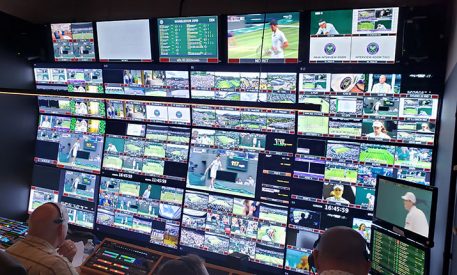 This year’s Wimbledon tennis Championships was year two of a four-year relationship between Wimbledon Broadcast Services (WBS) and NEP whereby the latter is providing technical gear and engineering services for the tournament. And while year two of deals can occasionally see some major changes and overhauls, the Wimbledon technical plan saw only minor changes as the initial efforts in year one were sufficiently forward-thinking: embracing technologies like ST 2110, UHD, and HDR.
This year’s Wimbledon tennis Championships was year two of a four-year relationship between Wimbledon Broadcast Services (WBS) and NEP whereby the latter is providing technical gear and engineering services for the tournament. And while year two of deals can occasionally see some major changes and overhauls, the Wimbledon technical plan saw only minor changes as the initial efforts in year one were sufficiently forward-thinking: embracing technologies like ST 2110, UHD, and HDR.
“We improved on some things, but technology wise it is the same,” said Richard Lancaster, NEP UK, technical project manager for Wimbledon. “But there were some geography changes like moving our engineering office out of the Master Control Room area.”
Another location change was that the Trace operations for the seven outside courts, which were produced using Simplylive production systems and camera systems from Fletcher, moved into the broadcast center.
Those systems were improved via software tweaks and also features like a Snapshot function that would allow for the operator of the system to swap between, say, a player in the foreground or background when working with automated tracking. Operators were also able to work on multiple courts at once and three operators were able to handle all seven courts.
The core of the WBS facility provided by NEP inside the Wimbledon Broadcast Centre were once again two completely redundant Grass Valley IQ modular systems that worked in conjunction with Arista Network switches. The router was decentralized with various nodes around the Broadcast Centre for the rightsholders. Outside of the WBC were three NEP OB units: Venus, Ceres, and Emerald from NEP Ireland where matches on Centre Court, No. 1 Court, and No. 2 Court were produced.
The Open Championship
Royal Portrush Golf Club, Portrush, UK
July 18-21
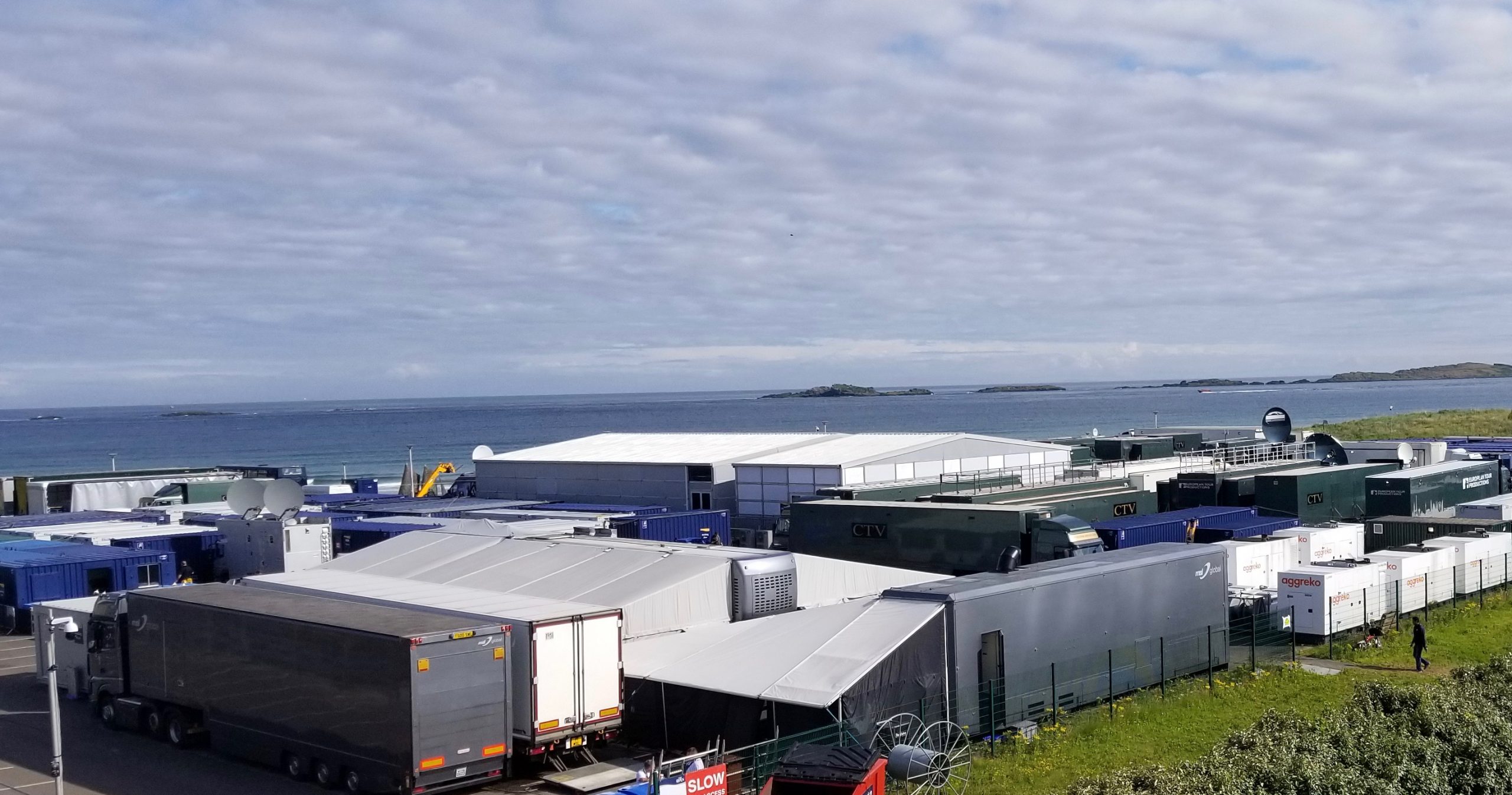 The 148th Open Championship returned to Royal Portrush in Northern Ireland for the first time since 1951, which gave some fresh energy to the CTV OB and ETP Production teams. And the effort saw some Open Championship firsts for the production, including the compound’s location on a beachside parking lot and the compound’s shutdown due to serious flooding caused by biblical rains during a setup day.
The 148th Open Championship returned to Royal Portrush in Northern Ireland for the first time since 1951, which gave some fresh energy to the CTV OB and ETP Production teams. And the effort saw some Open Championship firsts for the production, including the compound’s location on a beachside parking lot and the compound’s shutdown due to serious flooding caused by biblical rains during a setup day.
“We literally had to shut down the compound and then, the next morning, raised all the power onto platforms,” said Alan Jessop, technical producer, CTV OB. “We solved all the issues and then brought everything up again.”
The beachside parking lot is home to 11 CTV OB production trucks, 17 support units, catering, and office trailers. At the core of the production were 175 cameras.
RF cameras and mics were also part of the mix, with 29 RF cameras, 79 low-power radio mics, 50 high-power radio mics, and more than 600 walkie talkies. There were also 35 EVS XT3 servers and an EVS VIA server, which was used for UHD and HDR coverage of Holes 5, 6, and 7.
A lipstick camera was located at the first tee box, and rail cameras are at Holes 1, 3 (at the tee box), 6, 13, and 16. Four locked-off POV cameras, one Smarthead POV camera, and nine bunker cameras ere also part of the plan, and 11 holes were cabled for Toptracer (there are also two RF Toptracers: one for NBC and one for host-feed producer ETP).
NOTE: This Road Warriors article appears in the 2020 SVG Mobile Production Yearbook. CLICK HERE to read the digital version of the full publication now!
